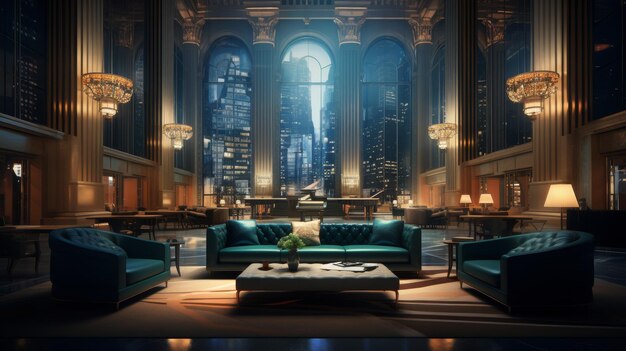
Immersive Interiors are rapidly transforming the way we design and experience spaces. No longer are interiors simply functional; they are now becoming increasingly interactive, engaging, and deeply personalized. Imagine walking into a room that responds to your presence, a space where technology seamlessly blends with aesthetics, and where every detail is crafted to evoke a specific emotion or memory. This is the promise of immersive interiors, and this article will guide you through this exciting new world of design. We’ll explore the key trends shaping this movement, examine real-world examples, and offer actionable strategies for integrating immersive elements into your own spaces. Get ready to dive into the future of interior design!
The Rise of Immersive Interior Design
Defining Immersive Interiors
Immersive interiors go beyond simply decorating a room. They create multi-sensory experiences that engage the user on multiple levels—visually, auditorily, even tactilely. It’s about blurring the lines between the physical and digital worlds to create spaces that feel alive and responsive. Think interactive displays, personalized lighting, and even haptic feedback integrated into furniture.
Why Immersive Design Matters
In today’s fast-paced world, people crave experiences that are meaningful and engaging. Immersive design offers a solution by creating spaces that are personalized and emotionally resonant. It’s a way to cater to the individual’s needs and preferences, making spaces feel truly unique and welcoming. Moreover, businesses are increasingly adopting immersive technology in retail and hospitality to enhance the customer experience and create memorable brand interactions.
The Challenges of Implementation
While the potential of immersive interiors is immense, there are challenges to overcome. Cost can be a significant factor, as implementing advanced technologies requires investment. Furthermore, it’s crucial to balance technological innovation with thoughtful design, ensuring that technology enhances the experience rather than overwhelming it. The user experience must remain intuitive and accessible to a broad audience.
Key Trends Shaping Immersive Interiors
Technology Integration
This is arguably the most significant trend. Smart home technologies, from voice-activated assistants to automated lighting and climate control, are at the forefront. Moreover, the integration of AR and VR offers incredible opportunities to create truly interactive and engaging spaces. Imagine using an AR app to visualize varied furniture layouts before making a purchase or experiencing a virtual tour of a property before even stepping foot inside.
Sensory Engagement
Immersive interiors prioritize engaging multiple senses. Think carefully curated soundscapes that create a calming or energizing atmosphere. The use of textures and materials can enhance the tactile experience, adding depth and richness to the space. Even the scent of a room can be carefully considered to contribute to an overall immersive experience. Lighting, of course, plays a crucial function, shaping the mood and ambiance.
Personalized Experiences
The rise of personalization in interior design is directly tied to immersive technology. Data-driven insights allow designers to create spaces tailored to individual preferences. This could involve using smart lighting to adjust to an individual’s circadian rhythm or personalized temperature settings that automatically adjust throughout the day.
Real-World Examples of Immersive Design
The Interactive Museum Exhibit
Museums are increasingly embracing immersive technologies to create engaging exhibits. Interactive displays, augmented reality overlays, and even virtual reality experiences are transforming how visitors interact with artifacts and information. This creates a more enriching and memorable museum experience.
The Smart Hotel Room
Hotels are adopting smart technology to enhance the guest experience. Voice-activated controls, automated lighting, and personalized temperature settings are now common attributes in high-end hotels. This allows guests to tailor their environment for optimal comfort and convenience.
The Experiential Retail Space
Retailers are using immersive technologies to create unique shopping experiences. Interactive displays, virtual try-on experiences, and personalized recommendations all contribute to creating a more engaging and memorable shopping experience.
Integrating Immersive Elements into Your Design Projects
Start Small, Think Big
Begin by integrating simple smart home technologies, like smart lighting or voice-activated assistants. This allows you to get a feel for the potential of smart technology without a huge upfront investment. Gradually add more advanced technologies as you gain experience and confidence.
Prioritize User Experience
Ensure that any technology you incorporate is easy to use and accessible to all users. Intuitive design is paramount. Avoid technology that is overly complicated or confusing. Focus on creating seamless and enjoyable experiences.
Consider the Budget
Immersive design can scope from relatively inexpensive to extremely costly, depending on the technologies involved. Set a clear budget from the outset and stick to it. Prioritize the technologies that will offer the most value for the cost.
The Future of Immersive Interiors
Advancements in Technology
We can expect continued advancements in AR, VR, and AI, leading to even more immersive and personalized experiences. Imagine spaces that adapt to your mood and preferences in real-time, or virtual design tools that allow you to completely visualize a space before construction even begins.
Sustainability and Immersive Design
The increasing focus on sustainability will also impact the development of immersive interiors. Smart home technology can help maximize energy use, and the use of sustainable materials will be key to creating environmentally responsible immersive spaces.
The Growing Importance of User Experience
As immersive technologies become more commonplace, the focus will shift even more towards ensuring intuitive and seamless user experiences. This means developing systems that are easy to use and adapt to the individual needs of the user. Intuitive design will become increasingly crucial.
In conclusion, exploring and implementing immersive interior design trends offers a unique chance to transform spaces and enhance the user experience. By understanding the key elements of immersive design—such as technological integration, sensory engagement, and personalized experiences—you can create environments that are not just visually appealing but also emotionally resonant and functionally effective. Embrace these trends to create truly unforgettable and engaging spaces for your clients or yourself. Start exploring the possibilities today!
